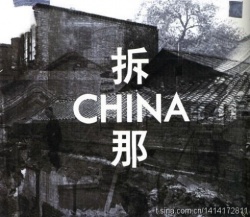“Demolish it”的版本间的差异
来自China Digital Space
| 第11行: | 第11行: | ||
Throughout China, 拆 is spray-painted or stenciled on the sides of buildings slated for demolition. People who have had their homes demolished are called 拆迁户 (chāiqiānhù). | Throughout China, 拆 is spray-painted or stenciled on the sides of buildings slated for demolition. People who have had their homes demolished are called 拆迁户 (chāiqiānhù). | ||
| − | Chāi nǎ is included in Linguist | + | Chāi nǎ is included in Linguist [http://languagelog.ldc.upenn.edu/nll/?p=4026 Victor Mair's collection of nicknames for China]. |
<feed url="feed://chinadigitaltimes.net/china/forced-demolitions/feed/" entries="10"> | <feed url="feed://chinadigitaltimes.net/china/forced-demolitions/feed/" entries="10"> | ||
2014年8月29日 (五) 21:32的版本
拆哪 (chāi nǎ): demolish it
Chāi nǎ mimics the sound of the English word “China.”
“Demolish” (拆 chāi) has a special meaning in contemporary China, as demolitions, often forced on tenants with little or no compensation, are a major source of social instability. Developers and the local government profit greatly from forcibly evicting people from their homes to build on the land. Anger over forced demolitions led the people of Wukan, Guangdong to fight the local government, eventually laying siege to their village in December 2011.
哪 nǎ means “where” or “which.” Hence, Chāi nǎ also sounds like the question “Where/which should be demolished?” mocking the ubiquity of demolition.
Throughout China, 拆 is spray-painted or stenciled on the sides of buildings slated for demolition. People who have had their homes demolished are called 拆迁户 (chāiqiānhù).
Chāi nǎ is included in Linguist Victor Mair's collection of nicknames for China.
<feed url="feed://chinadigitaltimes.net/china/forced-demolitions/feed/" entries="10">
[{PERMALINK} {TITLE}]
{DATE}, by {AUTHOR} </feed>






